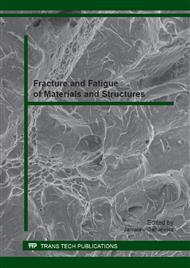p.13
p.20
p.26
p.32
p.39
p.45
p.51
p.57
p.63
Influence of Pearlite Morphology on Creeping Characteristic Curves of R260 Steel
Abstract:
The elements of railway turnouts made from rail sections of R260 high carbon steel must have a high resistance to abrasive and contact fatigue wear, as well as a good resistance to cracking under service loads. These mechanical properties largely determine the suitability of steel for use as railway track components. In this study, two groups of specimens were subjected to tests of mechanical properties and metallurgical analyses. The first group included material obtained from the hot-rolled block section, the rolling end temperature being Tkw = 950°C, while the second group was material after the rolling process with the subsequent 20-minute isothermal annealing at a temperature of 480°C. The microstructure of tested materials (Rm, Rp0.2, A5, Z, HB) was characterized, and their basic mechanical properties and fracture toughness in the KIc plane strain condition were determined. Also the effect of temperature, ranging from-80°C to 100°C, on the KCU impact toughness of R260 steel was established. Based on the SEM observation using the Hitachi S-3400N scanning microscope, it was found that pearlitic structure with a varied distance between cementite plates, equal to 0.29 μm and 0.09 μm, respectively, appears in the hot-rolled R260 steel and in the steel subjected to additional isothermal annealing treatment. The impact of pearlite morphology on the cracking characteristics and basic mechanical properties of materials was analyzed. It was found that at room temperature, the higher fracture toughness (KIc = 66.4 MPa·m1/2) is shown by the steel after isothermal annealing at 480°C, in which less distance between the plates of cementite has been observed in the perlite. The fracture toughness of R260 steel after hot rolling at 950°C was KIc = 48.3 MPa·m1/2. As in the case of fracture toughness, the impact strength of R260 steel after isothermal annealing was significantly greater than the impact strength of steel only after hot rolling. The determined cracking characteristics of R260 steel make it possible to determine the effect of heat treatment on the formation of microstructure and material properties, which determine the service life of rail sections.
Info:
Periodical:
Pages:
39-44
Citation:
Online since:
January 2014
Authors:
Price:
Сopyright:
© 2014 Trans Tech Publications Ltd. All Rights Reserved
Share:
Citation:


